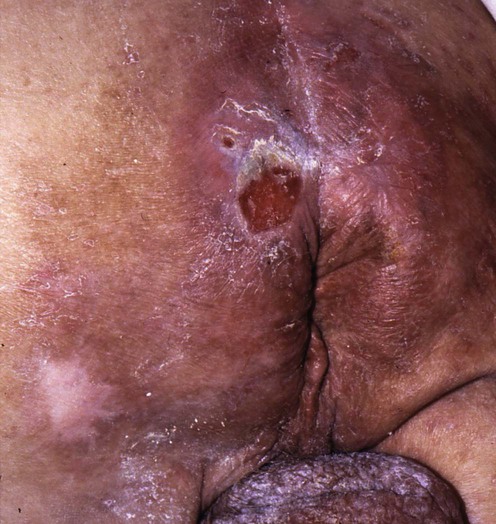Joseph A. Witkowski, Lawrence Charles Parish, Caren Campbell and Jennifer L. Parish
Decubitus ulcers

Management strategy
Prevention
General measures
 Saline should be used to clean most pressure lesions; soap and disinfectants are too irritating for more than occasional use.
Saline should be used to clean most pressure lesions; soap and disinfectants are too irritating for more than occasional use.
 When ulcers are not infected, synthetic dressings should be changed only if they become dislodged or wound fluid escapes from under the dressing.
When ulcers are not infected, synthetic dressings should be changed only if they become dislodged or wound fluid escapes from under the dressing.
 Periulcer skin must be kept dry not only to avoid maceration but also to permit the dressing to adhere to the skin.
Periulcer skin must be kept dry not only to avoid maceration but also to permit the dressing to adhere to the skin.
 To obliterate dead space, fill deep ulcers loosely with a hydrocolloid, a hydrogel wound filler, or an alginate rope before applying a synthetic dressing. This same material should be placed under the edge of the ulcer when undermining is present. Bleeding after serial surgical debridement can often be controlled with an alginate dressing; the calcium alginate assists in the clotting pathway. Moistening with saline can loosen an alginate dressing that adheres to granulation tissue.
To obliterate dead space, fill deep ulcers loosely with a hydrocolloid, a hydrogel wound filler, or an alginate rope before applying a synthetic dressing. This same material should be placed under the edge of the ulcer when undermining is present. Bleeding after serial surgical debridement can often be controlled with an alginate dressing; the calcium alginate assists in the clotting pathway. Moistening with saline can loosen an alginate dressing that adheres to granulation tissue.
 A clean ulcer failing to show signs of healing, or an ulcer with persistent excessive exudate, should be treated with antibacterial agents, e.g., 1% silver sulfadiazine, cadexomer iodine, triple antibiotic, or retapamulin, for 2 weeks to reduce the bacterial burden. Increased bacterial burden may impede healing before clinical signs of infection become apparent. The odor of an infected ulcer can often be eliminated by applying metronidazole gel to the ulcer bed. Systemic antimicrobial agents are indicated for patients with bacteremia, sepsis, advancing cellulitis, or osteomyelitis.
A clean ulcer failing to show signs of healing, or an ulcer with persistent excessive exudate, should be treated with antibacterial agents, e.g., 1% silver sulfadiazine, cadexomer iodine, triple antibiotic, or retapamulin, for 2 weeks to reduce the bacterial burden. Increased bacterial burden may impede healing before clinical signs of infection become apparent. The odor of an infected ulcer can often be eliminated by applying metronidazole gel to the ulcer bed. Systemic antimicrobial agents are indicated for patients with bacteremia, sepsis, advancing cellulitis, or osteomyelitis.
 Although most synthetic dressings relieve pain, treatment for moderate to severe pain can include topical anesthetics, non-steroidal anti-inflammatory drugs (NSAIDs), opiates, antidepressants, and sedatives. Many patients with decubitus ulcers do not have pain.
Although most synthetic dressings relieve pain, treatment for moderate to severe pain can include topical anesthetics, non-steroidal anti-inflammatory drugs (NSAIDs), opiates, antidepressants, and sedatives. Many patients with decubitus ulcers do not have pain.
Decubitus ulcers













